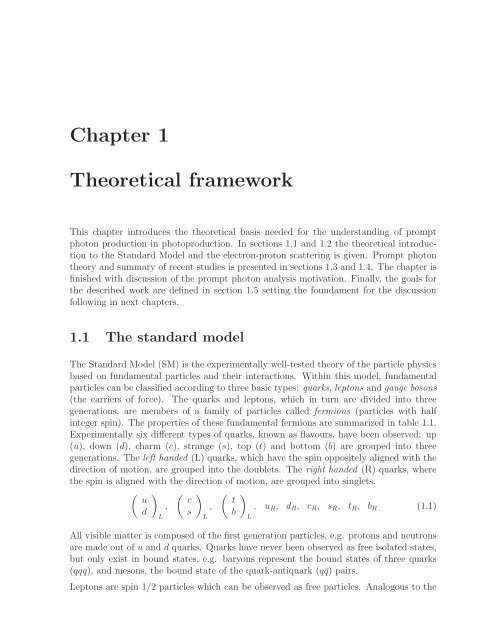10 - H1 - Desy
10 - H1 - Desy
10 - H1 - Desy
Create successful ePaper yourself
Turn your PDF publications into a flip-book with our unique Google optimized e-Paper software.
Chapter 1<br />
Theoretical framework<br />
This chapter introduces the theoretical basis needed for the understanding of prompt<br />
photon production in photoproduction. In sections 1.1 and 1.2 the theoretical introduction<br />
to the Standard Model and the electron-proton scattering is given. Prompt photon<br />
theory and summary of recent studies is presented in sections 1.3 and 1.4. The chapter is<br />
finished with discussion of the prompt photon analysis motivation. Finally, the goals for<br />
the described work are defined in section 1.5 setting the foundament for the discussion<br />
following in next chapters.<br />
1.1 The standard model<br />
The Standard Model (SM) is the experimentally well-tested theory of the particle physics<br />
based on fundamental particles and their interactions. Within this model, fundamental<br />
particles can be classified according to three basic types: quarks, leptons and gauge bosons<br />
(the carriers of force). The quarks and leptons, which in turn are divided into three<br />
generations, are members of a family of particles called fermions (particles with half<br />
integer spin). The properties of these fundamental fermions are summarized in table 1.1.<br />
Experimentally six different types of quarks, known as flavours, have been observed: up<br />
(u), down (d), charm (c), strange (s), top (t) and bottom (b) are grouped into three<br />
generations. The left handed (L) quarks, which have the spin oppositely aligned with the<br />
direction of motion, are grouped into the doublets. The right handed (R) quarks, where<br />
the spin is aligned with the direction of motion, are grouped into singlets.<br />
( ) ( ) ( )<br />
u c t<br />
, , , u<br />
d s b R , d R , c R , s R , t R , b R (1.1)<br />
L<br />
L<br />
L<br />
All visible matter is composed of the first generation particles, e.g. protons and neutrons<br />
are made out of u and d quarks. Quarks have never been observed as free isolated states,<br />
but only exist in bound states, e.g. baryons represent the bound states of three quarks<br />
(qqq), and mesons, the bound state of the quark-antiquark (q¯q) pairs.<br />
Leptons are spin 1/2 particles which can be observed as free particles. Analogous to the
















